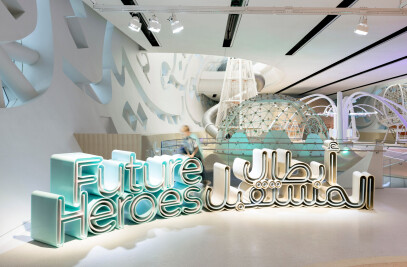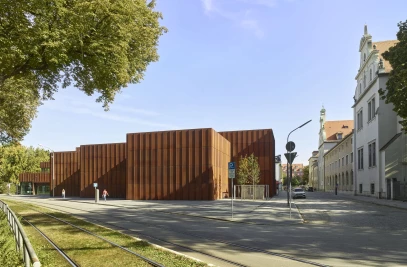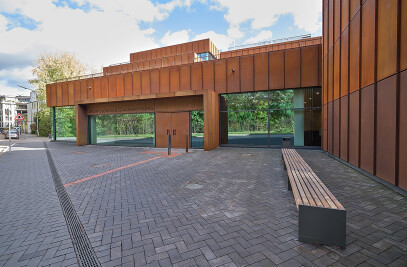The headquarters of Lindt & Sprüngli, the Swiss chocolatier, founded in 1845, are located near Lake Zurich on the outskirts of Switzerland‘s most populous city. The firm‘s long and successful history of producing quality chocolate manifests creations from Lindt & Sprüngli as the epitome of quality chocolate. Its products are available in more than 120 countries worldwide. They are sold by 28 subsidiaries in more than 500 of its own stores. Lindt & Sprüngli‘s HQ features a factory, warehouses, an office building, and the new gateway to the campus, the Lindt Home of Chocolate, which is financed and operated by the Lindt Chocolate Competence Foundation. This new flagship building is a striking, contemporary counterweight to the eclectic assemblage of buildings.
Set to become one of Switzerland‘s most visited buildings, this multifunctional experiential space combines a user-focused, mixed-use program in an exceptional new type of civic architecture. Elevating the visibility of the Swiss Chocolate industry to new heights, it is built to seduce visitors with the many charms of chocolate. It features an interactive, immersive exhibition about chocolate, a research and development facility for future chocolate recipes, a production plant, a chocolate shop, a cafe, and offices – all connected by spiraling staircases and cascading walkways crisscrossing a vast atrium. In its center, a dramatic, nine-meter high, golden chocolate fountain was developed by Atelier Brückner, also authors of the exhibition.
Designed by Christ & Gantenbein, the Home of Chocolate parallels Lindt & Sprüngli‘s factory site‘s logic, history, and urban structure: A classically composed, industrial box, in dialogue with the surrounding factory buildings. The facade, consisting primarily of red brick, references its neighbors in an abstract reinterpretation based on a readymade industrial product that is manually grafted into a specific construction element. The south-eastern corner is cut out and interrupts the otherwise simple volume. Clad with white, glazed brick adorned with golden letters, this quadrant opens a public square right at the Lindt Home of Chocolate‘s entrance.
A vast atrium, 64 meters long, 15 meters high, and 13m wide, reveals both a dramatic void and the architectural order‘s elementary presence. A series of round load-bearing pillars and walls create a robust structure around which all activities are organized.The columns reveal a building full of movement; stairs, elevators, walkways, and bridges produce spatial and experiential connectivity and communication, which is at the core of the Lindt Home of Chocolate, radically contrasting its almost calm exterior.
At first glance, what appears simple is actually an intelligently engineered building of multifaceted complexity; a solid architectural form built to last, yet at the same time, built to withstand fluctuations through flexibility; where resilience and robustness collaborate towards a multiplicity of potentially shifting applications. The Lindt Home of Chocolate‘s structural system is itself a hybrid, where aesthetic, functionality, and construction come together in a column-free volume with a load-bearing outer shell.
Emanuel Christ says …“Almost reaching an ancient Roman scale, we‘ve created an exaggeration of industrial production with a certain tension; a tension that gives a strong presence to the architecturally distinct elements that define the interior, bridging the substantial gap between a commercial ambiance and classical grandeur. To celebrate the experience of chocolate in many ways, we‘ve scripted the Lindt Home of Chocolate‘s interior as a space that orchestrates the movement of people.
Jürg Conzett, structural engineer for the Lindt Home of Chocolate: „The supporting structure in the interior essentially consists of an in-situ concrete skeleton. In the area of the atrium, the loadbearing parts become multifunctional elements. Thus, mushroom pillars mutate into cantilevered balconies, and hollow columns contain elevators as well as zones for pipes to ascend. Generously dimensioned spiral staircases also circle around these vertical support elements. The unusually large dimensions of the supporting structure create a unique scale and contribute to the extraordinary spatial effect of this building.
The Lindt Home of Chocolate, Christ & Gantenbein‘s second completed cultural project in Zurich, besides the Swiss National Museum and its extension, is a highly technical and complex hybrid. Combining industrial production, showroom, museum, shopping, and cutting-edge research & development, among others in collaboration with the Swiss Federal Institute of Technology, it‘s ultimately a space where contemplation, entertainment, research, and interaction come together in a new spatial experience.










































